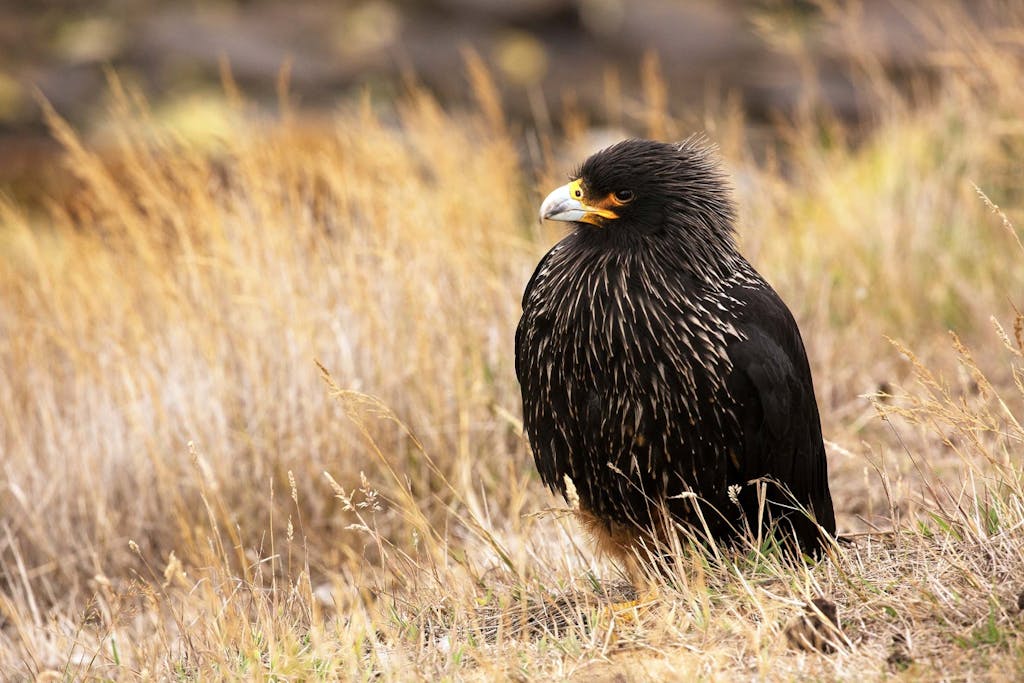Striated Caracaras: Тhe Mischievous Stars of Falkland Islands’ Wildlife
A rare species of raptor makes its home in the cliff faces and coves of the Falkland Islands, scavenging for food and sometimes teasing the travelers who visit these remote islands. Striated Caracaras are striking, chocolate-brown birds with dark eyes, golden faces and silver-streaked necks. Named “striated” for those silvery stripes and “caracara” after their spirited calls, these long-legged birds run quickly on land and soar gracefully on gusty updrafts. And they’re not shy at all.
The striated caracara’s wingspan makes it quite the aerial acrobat. “Their broad wings, with ‘fingers’ at the tips, allow for great aerial maneuverability that alternates between gliding and flapping,” says Lex van Groningen, a bird enthusiast, photographer and Silversea Cruises Expedition Expert. He says guests traveling through the Falkland Islands might catch fascinating hunting displays, as Striated Caracaras sail over seabird colonies and swoop down to seize their prey. These opportunistic scavengers also have a playful side, and sometimes boldly scoop up unattended camera bags or scarves.
Van Groningen digs into the natural history and behavior of these captivating caracaras, detailing what guests can expect as they view the birds throughout the Falklands.

Why is the Striated Caracara called Johnny Rook
The caracara is the acknowledged star of Falkland Islands birding tours, but it also goes by a different name. “The Striated Caracara, or Phalcoboenus australis, is the best-known caracara on the Falklands,” says van Groningen. “Local inhabitants also call the species ‘Johnny rook’ or ‘Jack rook’.” Explanations for that nickname vary. Some naturalists link it to the Gentoo Penguin, also dubbed the “Johnny penguin”. Penguins, including Gentoos, are part of the Striated Caracara’s diet. Other sources believe the nickname draws upon the roguish nature of this highly inquisitive bird.
“If you visit the Falklands, make sure you never leave your bag or other items unattended. Caracaras are fast and agile, and may fly off with your camera or binoculars, which they will drop elsewhere,” says van Groningen. “This behavior may be linked to their opportunistic feeding habits: juveniles spend a considerable time experimenting with which items are food and which are not.”

The Darwin Connection
The impish reputation of Johnny rook makes its way into literature dating back nearly 190 years. When a young Charles Darwin explored the Falklands in the 1830s, the naturalist observed lively Striated Caracaras at work. He recorded some of the earliest documented Caracara bird facts. “They were constantly flying on board the vessel when in the harbor, and it was necessary to keep a good lookout to prevent the leather being torn from the rigging,” wrote Darwin, chronicling his journeys aboard the HMS Beagle. “These birds are very mischievous and inquisitive; they will pick up almost anything from the ground; a large black glazed hat was carried nearly a mile…”
“Johnny rooks are very inquisitive,” confirms van Groningen.” Charles Darwin noted this when he described them in 1833 and 1834 as ‘extraordinarily tame and fearless’ and ‘very mischievous and inquisitive,’ but also ‘quarrelsome and passionate’. He commented that the birds will constantly pick up all kinds of offal left around the houses. Even today, these caracaras will investigate any backpack you leave behind and try to tear it open with their sharp beaks.”

Conservation in Action
Following a 20th century population decline, the Striated Caracara is slowly making its comeback. Hunters once favored the birds because of their tame nature. The birds were also targeted by sheep farmers, because the scavengers would sometimes attack lambs or wounded sheep. “In the 1960s, however, these birds got real protection and numbers managed to recover,” says van Groningen. The International Union for Conservation of Nature labelled the Striated Caracara as “near threatened,” and laws now protect these remarkable birds. A significant percentage of the global population currently lives on the Falkland Islands, making it one of the more unique South American birding destinations. Ongoing protection of key breeding sites will contribute to the species’ long-term success.

Spotting the Striated Caracara
Striated Caracara populations span the Falkland Islands, Chile and the wider Tierra del Fuego region. Their current global population totals between 1,000 and 2,500 individual birds, according to BirdLife International estimates. A census published in 2018 recorded about 350 breeding pairs in the Falklands, plus another 477 probable local pairs.
“The five islands with the highest numbers of breeding pairs — Grand Jason, Steeple Jason, New Island, Beauchene Island and Bird Island — hold half of the breeding population,” van Groningen says. Throughout the Falklands, he explains, Striated Caracaras build their nests along coastal cliffs using twigs, grass and bits of wool. They often place themselves near sources of food, including seabird colonies, and areas of dense tussoc grass where prey may burrow. Occasionally, carrion is stolen from scavenging birds, such as Turkey Vultures and skuas.

Striated Caracaras typically lay between two and four eggs in October and November. Chicks start venturing from their nests in February. “At this time of the year, caracaras are conspicuous and easy to count. Adults spend much time perched along the cliffs or foraging on the ground nearby, and young birds are permanently calling and attempting the first flights in the vicinity of their nest,” says van Groningen.
Whether you’re here for a Falkland Islands bird-watching expedition or as a casual tourist, the inquisitive Striated Caracara is likely to be part of your experience. A glimpse of these splendid raptors gliding above jagged coastal cliffs, parading through grassy expanses in search of prey, or striding toward a scarf left unattended, is unforgettable. Watching the spirited species in their natural habitat—scenic, weathered islands and wildly beautiful seas—makes for an engaging and extraordinary journey.
Learn more about seabirds in the Falklands.

